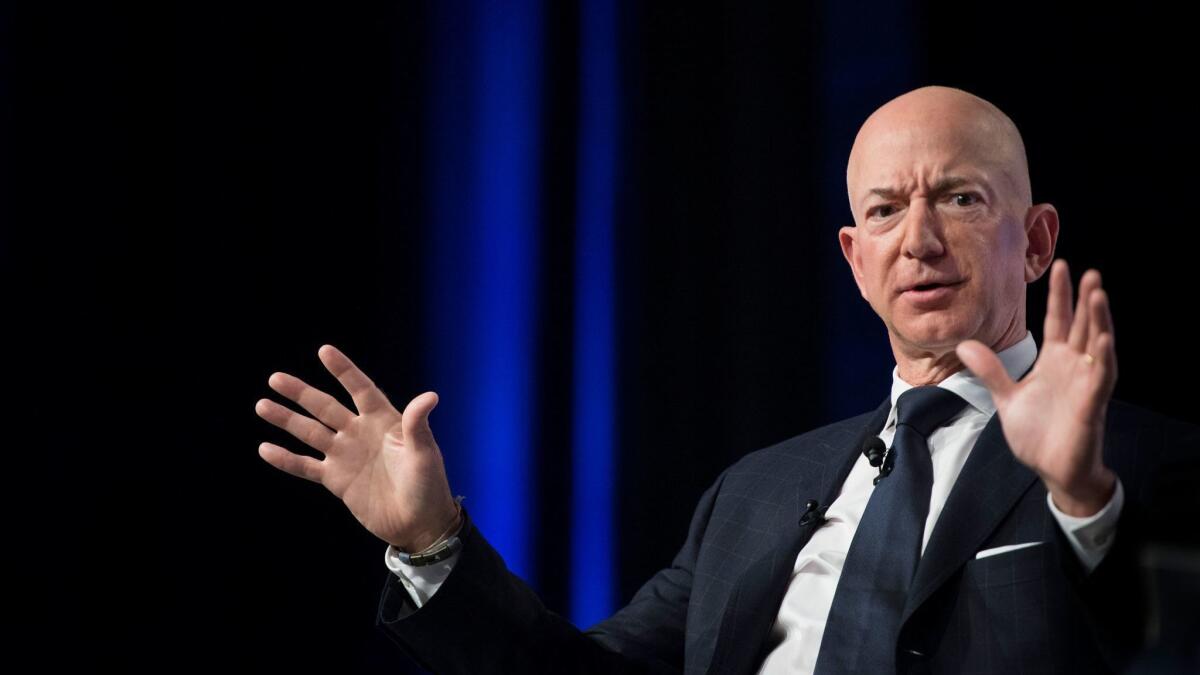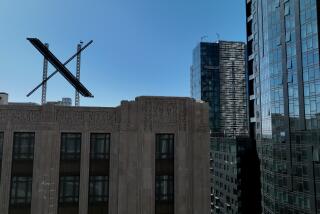Column: Amazon’s pullout from New York shows that it misplayed a bad, and expensive, hand

Well, that should show them.
Stung by intensifying opposition to a $3-billion incentive handout from New York city and state, Amazon on Thursday abruptly canceled its plans to build a new half-headquarters complex in the New York City borough of Queens.
The outcome is shaping up as a disaster — but arguably for Amazon more than New York. It reinforces the giant company’s reputation as a grasping bully that cares little for the communities where it operates.
People in New York knew what had happened in Manhattan.... They saw this project coming in and putting that on steroids.
— Greg LeRoy, Good Jobs First
Amazon’s withdrawal from New York may well inspire more opposition to its quest for incentives and other accommodations in northern Virginia, which was to share the big headquarters development with New York, and other communities where Amazon dangled the prospect of major business expansion.
“This is going to be a rapidly metastasizing process where people are going to be emboldened to push back,” Richard Florida of the University of Toronto, an urban development expert and critic of Amazon’s plans, told me.
It will also intensify scrutiny on the impact that major corporate expansions have on their communities. In Amazon’s case, its original headquarters city of Seattle has been struggling with the displacement of residents and businesses by soaring housing costs and commercial rents and Amazon’s resistance to contributing some of its billions of dollars in resources to alleviate the problems.
In New York, where displacement and gentrification had already become a political flashpoint, Amazon’s entry was almost certain to make things worse.
“People in New York knew what had happened in Manhattan, what has almost finished happening in Brooklyn, and was already happening in Queens,” said Greg LeRoy, executive director of Good Jobs First, which tracks excessive corporate incentives. “They saw this project coming in and putting that on steroids.”
Let’s briefly recap the process that brought us to this point. Amazon announced in September 2017 its plans to create a second headquarters satrapy somewhere in North America to share responsibilities with Seattle. The prospect of a $5-billion complex staffed with 50,000 employees earning $100,000 or more predictably set up an orgy of civic preening and, more to the point, immense offers of tax breaks and other incentives worth billions of dollars.
The company played 238 cities, states and regions off against one another until last November, when it announced that the brass ring had been won jointly by northern Virginia and New York.
On the face of things, this whole process was a sham from the start. Amazon’s original request for proposals specified a metro area of at least 1 million population; an international airport no more than 45 minutes away; mass transit service on-site and major highways not more than two miles distant; a “highly educated labor pool”; good cellphone and fiber coverage; and a political and social culture that supports “a diverse population” and an “overall high quality of life.”
But Amazon also made clear its interest in seeing bidding communities come up with the long green: “Please provide a summary of total incentives offered for the Project by the state/province and local community,” its bid document said. “Please provide a brief description of the incentive item, the timing of incentive payment/realization, and a calculation of the incentive amount.”
Whether out of hubris or ignorance, the company seemed to be blindsided by the community opposition to its selection of the Queens community of Long Island City for one half of its new headquarters, at a price of nearly $3 billion in state and local incentives.
“Jeff Bezos should fire his whole site selection staff,” said Florida, referring to Amazon’s chairman and chief executive. “If they had done their due diligence, they would have known there would be a backlash — with this level of incentives in a big city like New York, with a very strong activist community, and a progressive-leaning city council and state legislators — they weren’t going to stand for this level of corporate welfare, and they didn’t.”
The political skepticism the project would inspire wasn’t hard to divine — the New York site is adjacent to the district in which progressive firebrand Alexandria Ocasio-Cortez unseated a long-term machine Democrat in a party primary for Congress. Ocasio-Cortez’s election to the House came only a week before Amazon’s site announcement.
“Who in their right mind would put this project at Alexandria Ocasio-Cortez’s front door?” Florida asked.
But Amazon had grown accustomed to bending local politicians to its will. That was certainly the case in Seattle, where the company last year bullied the City Council into repealing a “head tax” that would have raised $45 million over five years from big corporations, chiefly Amazon.
That history seemed to blind Amazon to the need to help its host communities deal with the indisputable costs associated with large-scale development, especially in places already suffering from overdevelopment.
“A company has to figure out that if it wants to be in a community, it has to do it quietly and deftly and gently, and pay its fair share of taxes and be a good corporate citizen,” Florida said. “Why would you try to extract stuff like this from your new hometown?”
Amazon might have been able to tamp down the opposition. “One can guess that Amazon might have gained entry by engaging with local groups and trying to address local impacts,” LeRoy told me. “But that would require Amazon’s DNA changing. Everyone in New York knew what they did to Seattle with the head tax. They have no illusions about how much ice runs through Amazon’s veins.”
Amazon plainly became a prisoner of its own demand for municipal handouts. After its incentives materialized in New York, the company tried to downplay the role of tax incentives in its decision.
“Incentives did not drive this process for us,” company spokesman Jay Carney said. “Our No. 1 criterion for us was the availability of existing talent and the possibility of recruiting and luring new talent to come.”
Yet its withdrawal from New York effectively lays that claim to rest. Nothing has changed in the last three months about the “availability of existing talent” in Long Island City or the potential for recruiting new employees to a neighborhood just over the river from Manhattan. The only change was in the apparent willingness of residents and their political representatives to roll over for a $3-billion incentive deal for a company that manifestly does not need the money.
What may be most perplexing about this case is that in strictly financial terms, even the $3 billion in handouts offered by New York is a trivial sum for Amazon. Most of the money would be doled out over 10 years or more in the form of refundable tax credits (that is, Amazon would collect the credits even if they exceeded its tax liability to the state). How significant could that be for a company that earned $93.7 billion in gross profit on nearly $233 billion in revenue last year alone?
Moreover, it’s well established that tax incentives rank low on the list of factors in a company’s siting decision, overshadowed by many of the other factors cited by Amazon, such as the availability of a skilled workforce and transportation and communication infrastructure. Companies ask for the handouts, and take what they’re offered.
Yet having established local incentives as a decision factor, Amazon could not easily ignore the opposition in New York — what self-respecting community would pony up billions if the company showed that it was willing to give them up in this case?
LeRoy and Florida think the Amazon experience might be a turning point for American communities’ reliance on corporate incentives to attract jobs, even despite evidence that the incentives almost never pay for themselves.
Big companies haven’t stopped dangling the prospect of economy-changing impacts from their relocations in order to extract huge benefits. Some of these big deals have been blowing apart at the seams, notably a record-breaking $4.5-billion subsidy offered by Wisconsin to the Taiwanese electronics manufacturer Foxconn for a factory that is unlikely ever to be built — a deal promoted assiduously by President Trump and former Wisconsin Republican Gov. Scott Walker.
But Amazon’s deal had the highest profile of all — “Head and shoulders the biggest headquarters deal on the table,” LeRoy said. “Amazon’s attitude was, ‘You should be grateful we’re coming — we’re going to expect a big payout and you can figure out the fallout later.’”
LeRoy points to Bezos’ recent exposure of an alleged extortion attempt by the National Enquirer, which threatened to publish embarrassing photographs of Bezos if he didn’t cease investigating the Enquirer’s previous publication of his personal text messages. In his blog post about the Enquirer’s behavior, Bezos, the richest man in the world, wrote: “If in my position I can’t stand up to this kind of extortion, how many people can?”
By the same token, LeRoy said, “New York said to Jeff Bezos, if a city like us can’t stand up to this extortionate site location game you’re playing, who will?”
Keep up to date with Michael Hiltzik. Follow @hiltzikm on Twitter, see his Facebook page, or email michael.hiltzik@latimes.com.
Return to Michael Hiltzik’s blog.
More to Read
Inside the business of entertainment
The Wide Shot brings you news, analysis and insights on everything from streaming wars to production — and what it all means for the future.
You may occasionally receive promotional content from the Los Angeles Times.











